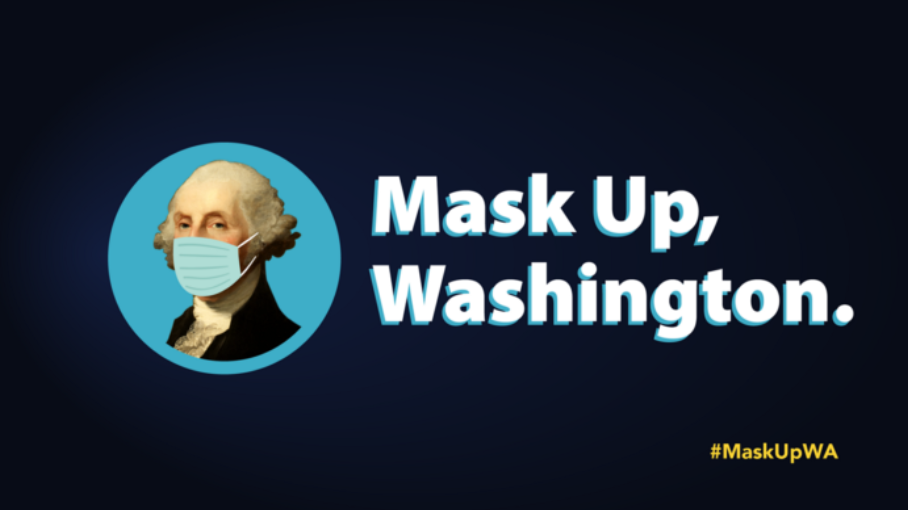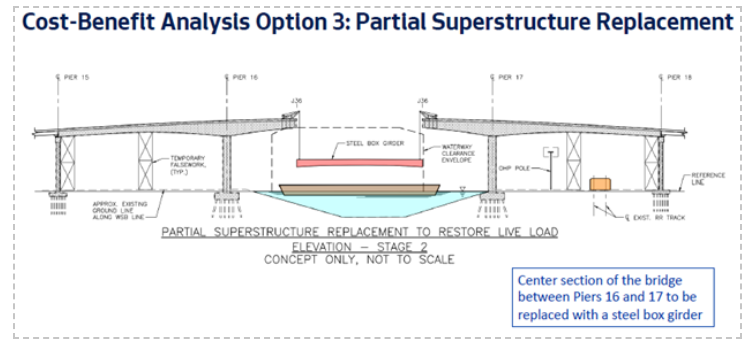Coronavirus Updates
Governor Inslee and Secretary of Health Wiseman announced yesterday restrictions on the “Safe Start” phased reopening in Washington. These restrictions come after an increase in the number of covid-19 cases. Across the state we now have over 50,000 cases, 1,500 deaths, and 5,000 hospitalizations due to the virus. In order to try and stymie the increase the Governor has changed the regulations for restaurants, bars, fitness centers, weddings, and funerals.
Most notably table size for dine-in in phase three is reduced to five people from the same household and total occupancy reduced from 75% to 50%. Alcohol service inside of restaurants must end by 10pm. These regulations will take effect on July 30.
Further, the Governor expanded the requirement to wear face coverings in all common spaces including: elevators, hallways and shared spaced in apartment building, universities and hotels as well as congregate settings such as nursing homes.
More specifically in King County we continue to see a rise in positive cases:
These numbers show that it’s more important now than ever before that we double down on social distancing, wearing a mask when in public areas, and staying home as much as possible in order to prevent backsliding anymore.
Finally, the Governor also extended the eviction moratorium across the state until October 15. In the city of Seattle we have additional protections for renters:
- Council Bill 119784 which creates a defense to evictions for non-payment of rent for six months after the end of the declared public health emergency. It requires that renters file a certification of financial hardship with the court in raising the defense.
- Council Bill 119788 which allows residential tenants to make up past due rent in installments up to six months.
- Council Bill 119787 which prohibits landlords from considering evictions related to COVID-19, as part of an application, during and six months after the civil emergency.
West Seattle Bridge Update, July 24
Reconnect West Seattle surveys open through July 31
South Park
Here are links to printable versions, that also include maps showing the location of potential projects: Roxhill, Highland Park, Riverview, South Delridge, South Park, Georgetown, SODO.
The website also includes bike network and freight network proposals.
Through July 22nd, over 10,000 people replied to the survey, and over 1,000 to the neighborhood prioritization ballots: 741 response from Highland Park, Roxhill, South Delridge, and Riverview; 161 responses from South Park, and 110 in Georgetown and 50 in SODO.
Additional information and surveys are available in multiple languages at the Reconnect West Seattle website.
My office has asked about Sylvan Way, which is seeing significant traffic impacts and accidents since the closure of the West Seattle Bridge. Specific proposals for Sylvan Way are not included in any of the neighborhood surveys; SDOT is examining this and may have separate proposals.
Lower Bridge Use
SDOT intends to increase access to the lower bridge during the summer, for maritime/industrial users by Harbor Island; 22 employer shuttles; 8 vanpools of essential workers, and for Longshoremen. Vehicles must display the placard below.

Cost Benefit Analysis: Repair or Replace
SDOT presented information about a cost benefit analysis to guide decision making about whether to pursue a replacement or repair the existing bridge. The analysis is proposed to be based on evaluation criteria; 10 draft criteria are listed below:
- Constructability Will the contractor be able to build this repair/replace concept given site constraints and schedule?
- Environmental What kind of temporary and permanent impacts will this repair/replace concept have on the Duwamish River and surrounding area? Can we build it within the mandated in-water work windows?
- Equity How will this repair/replace concept contribute to equity in West Seattle and the Duwamish Valley? How will it impact historic and treaty rights of local Native Peoples? How will it impact and/or alter communities of color from accessing cultural and community hubs?
- Forward compatibility Will this repair/replace concept be compatible with Sound Transit light rail? Will it restore traffic capacity (weight and quantity) to the desired levels? Will it meet waterway navigational needs?
- Funding What funding will be available, and what will the potential funding burdens be on local resources and communities? Is this repair/replace concept eligible for federal, state, local, or emergency funding? Estimated capital costs and a Bridge Life Cycle Cost Analysis will be conducted for each alternative, too.
- Maintenance and operations What will this repair/replace concept need over its lifespan in terms of operations, maintenance and inspection?
- Mobility How will this repair/replace concept contribute to the movement of people and goods and overall access? How will it impact vulnerable communities (seniors, people with disabilities and others) from accessing social service needs such as meals, healthcare services, case management and other vital services?
- Multimodality Does this replace/repair concept facilitate or improve the movement of people and goods by all modes? How will it impact current local and regional traffic?
- Regional business How will this repair/replace concept impact businesses as it pertains to the local and regional movement of people and goods? How will it impact the ship channel? Will construction affect business access?
- Seismic resilience and safety What seismic standards will the repair/replace concept meet? How will seismic upgrades be incorporated into the design?
If you have thoughts about the relative importance that should be given to the criteria, or see something important that is not listed, please let me know.
Below are the key dates SDOT sees for getting to a decision:
Below are six concepts SDOT is using for the cost-benefit framework. The times listed for the durability for a repair are 15+ years, longer than the previous 10 year maximum estimate, a sign that a repair may be more durable than original estimates indicated. I asked SDOT for additional information about this; they indicated it was based on engineering analysis on potential repair, such as the core sampling results, and instrument readings, and feedback from the Technical Advisory Panel. SDOT’s consultants and TAP will provide more specific estimates and detail as part of their work in coming weeks.
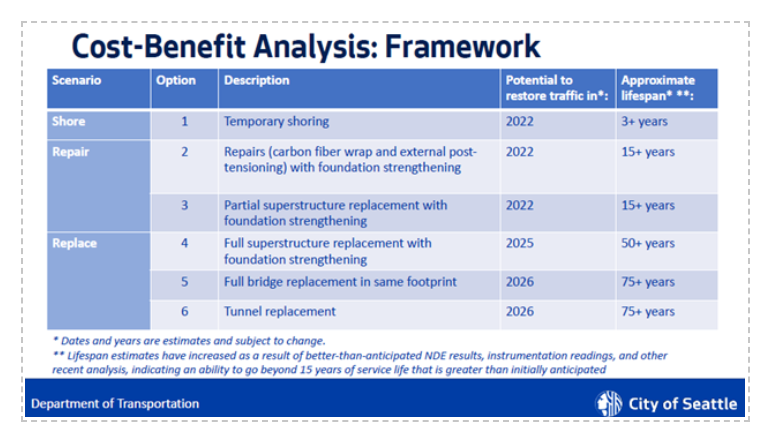
A Type, Size and Location study would be needed to determine actual options; these concepts are for the purpose of the cost-benefit analysis.
Here’s one of the repair concepts:
Here’s one of the replacement concepts:
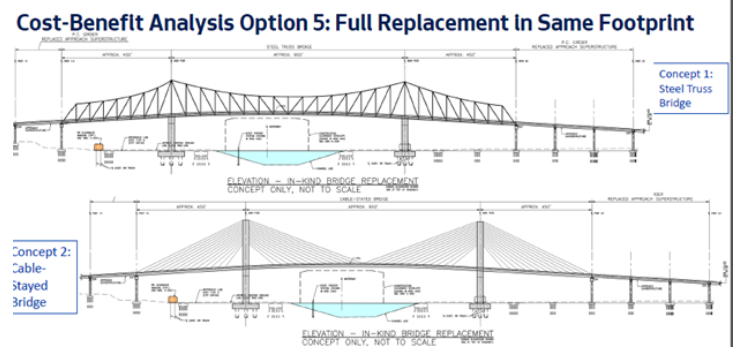
Here’s the tunnel concept:
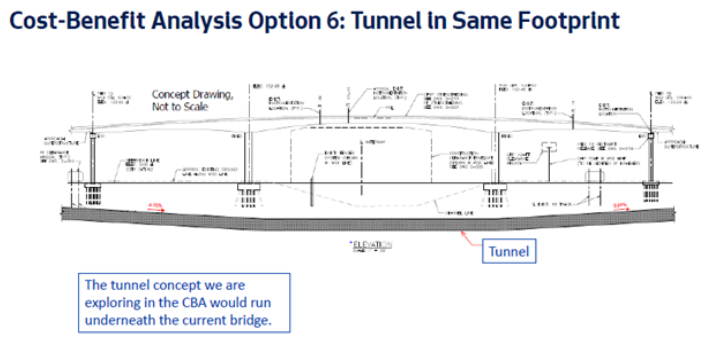
You can see all six options in this SDOT blog post.
Traffic/Travel Times
Travel times continue to be high on West Marginal and Highland Park Way, and above pre-COVID levels on the South Park Bridge and Roxbury at 15th, and on S Michigan in Georgetown, and 7% above pre-COVID levels on the 1st Avenue South Bridge (a WSDOT facility):
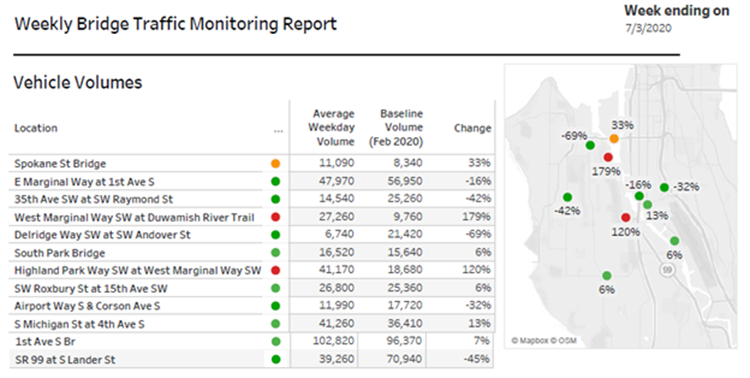
Here are the most recent travel time estimates:
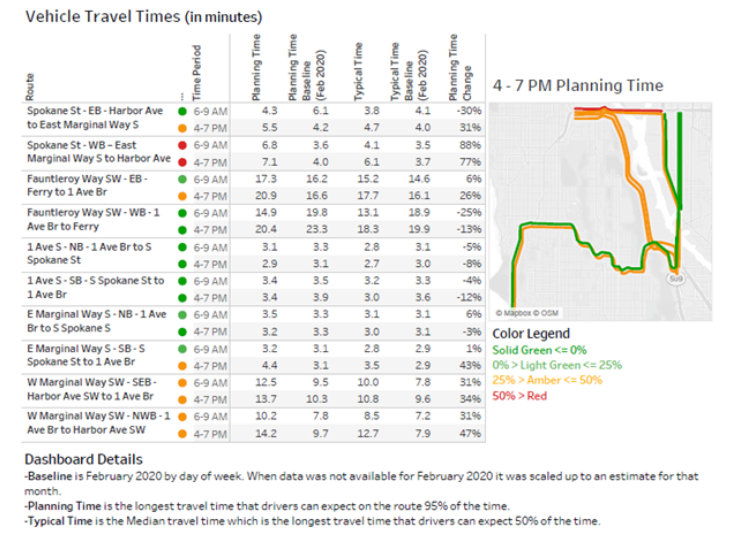
Seattle Transportation Benefit District Update/Bus Service
Last week the Council voted in committee to move the Seattle Transportation Benefit District (STBD) ballot measure to the Full Council for a final vote on Monday, July 27. The STBD funds additional bus service beyond what King County Metro provides.
The proposed 2020 measure includes funding for “emerging needs,” and specifies funding for West Seattle due to the closure of the West Seattle Bridge. In 2014 Seattle voters approved funding for additional bus service, low-income bus passes, and related services. The measure provided funding from 2015 through 2020.
I sponsored an amendment that the Council adopted to increase equity. The current criteria for service funding does not allow for funding routes such as the 131, 128 and 113 in Highland Park and South Delridge, or the 132 in South Park, because of the number of stops they have outside Seattle. The amendment would add as eligible routes “any King County Metro route serving historically low-income communities in Seattle.”
These routes also coincide with the most frequent routes off the peninsula with the closure of the West Seattle Bridge: Highland Park Way, and Roxbury/Olson. The South Park Bridge is seeing increased traffic diversion to cross the Duwamish; route 128 connects High Point with the Alaskan Junction, and a high concentration of grocery stores.
The remaining issues before the Council is whether the rate should be 0.1% or 0.2% sales tax, and whether it should last for four or six years. I-976 prohibited collection of the vehicle license fee that formed half of the revenues for current STBD funding. For car-owning lower-income households, increasing the sales tax from .1% to .2% will be far outweighed by not having to pay the car tab fee. The low-income households who don’t have a car would see their total tax burden rise by increasing the sales tax from .1% to .2%. The questions that remain for me, are 1. whether the impact to those households from reduced bus service is more harmful than the increased tax burden; and 2. whether an additional .1% tax, on top of the proposed .1%, and the additional funding it would raise specifically for the West Seattle “emerging needs” setaside, would help Metro add significant new transit capacity to support the SDOT mode shift goals of increasing West Seattle and South Park transit users from 17% (pre COVID19) to 30%.
At the West Seattle Bridge Community Task Force meeting, KC Metro shared a slide noting the transit hot spots for West Seattle bus traffic. Downtown and South Lake Union are destination points, but there are also a high level of trips within West Seattle:
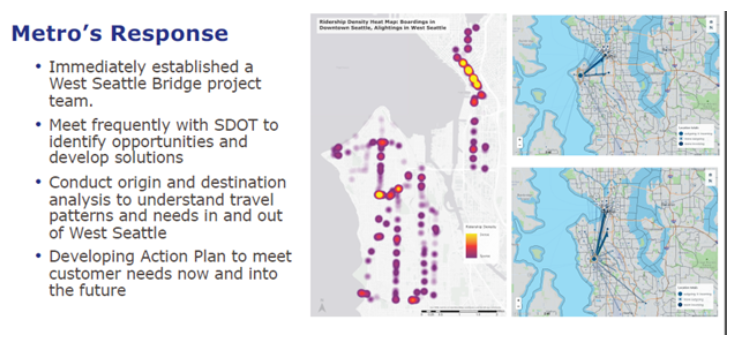
Bus trips 131, 132, 120, 128 and 50 are operating at 50% of pre-COVID baseline, while bridge crossings are around 20% of baseline.
Metro indicated in response to my office’s question, that a 0.1% STBD would be close to pre-COVID levels, but not at those levels. Below are items they mentioned that would need funding from outside KC Metro; I’ve heard from constituents about all of these:

Before COVID, in January 2020, the STBD funded within District 1, 24% of service on Routes 120 and 50, 28% for the C Line, 23% for Route 55, 9% for Route 57, 8% for Route 60, 14% for 125.
Statement on Trump sending officers to Seattle
Council President González and I released a statement this morning about the prospect of Donald Trump sending federal agents to Seattle, with no request from Seattle:
Council President González, Councilmember Herbold Say City of Seattle Stands United Against Occupation By DHS Federal Agents
Council President M. Lorena González (Position 9, Citywide) and the Council’s Public Safety Chair Councilmember Lisa Herbold (District 1, West Seattle & South Park) issued this statement following several reports that federal agents are on “stand-by” in Seattle monitoring potential protests around federal buildings:
“Seattle leaders have made it abundantly clear that federal local law enforcement intervention is unwanted and unneeded. Despite the collective call on the Trump administration to halt plans to come to Seattle, national and local media report that federal agents from the Department of Homeland Security (“DHS”) are on standby in Seattle. DHS is the same agency responsible for implementing President Trump’s horrific policy of separating children from their families seeking lawful asylum at the southern U.S.-Mexico border.
“President Trump’s deployment of federal agents to Seattle is dangerous political theater designed to intimidate and harm Americans exercising their constitutional right to protest. Weaponizing federal agents against the people they serve is unacceptable. Protests demanding transformational change to a broken policing model must not be met with threats of violence from federal agents.
“We will not allow the Trump Administration to reign terror on the residents of the City of Seattle. We are united in our belief that debate and demonstrations are fundamental to making our city and our country better.
“We ask all members of the public to be vigilant, to have a safety plan, and to know your rights, if you are demonstrating or are near demonstration areas. If you are detained, you have the right to remain silent and to speak to an attorney. The U.S. Constitution provides rights for everyone, regardless of your immigration status.
“Our offices will continue to monitor the federal agents’ presence in Seattle, and we will work with Mayor Jenny Durkan, Washington State Attorney General Bob Ferguson, Governor Jay Inslee, and our congressional representatives to halt any actions by federal authorities that violate our residents’ constitutional rights.”
On June 8, 2020, the Seattle City Council unanimously passed Resolution 31948 condemning the use of military force in jurisdictions such as Seattle that have not requested and do not intend to request federal interventions.
Separately, earlier this week we sent the following e-mail to the President of the Seattle Police Guild. We have received no reply.
We are writing to you today with alarm and concern about this weekend’s events in Portland: the arrival of Federal Law Enforcement to address local protests and usurp the authority of local law enforcement to address the public safety impacts of the protests. It is our sincere hope that you have neither met with federal law enforcement, nor collaborated with federal law enforcement, regarding recent protests in Seattle. We ask you to confirm, in writing, that you have done neither.
Seattle’s leaders are united in saying federal law enforcement is neither wanted nor needed here.
- On June 8th, Seattle City Council passed Resolution 31948 condemning the use of military force in jurisdictions such as “Seattle that have not requested and do not intend to request federal interventions.”
- Mayor Durkan, on June 1 issued a statement that “no U.S. Military troops are needed nor will they act as police in Seattle.” And today she signed a letter with Mayors from several other cities to call on the Trump administration to immediately halt plans to send federal forces to major American cities and withdraw any forces currently in cities.
- The Seattle City Council’s Public Safety and Human Services Committee Chair, Lisa Herbold, has confirmed that Seattle Police Chief Carmen Best has not met with Homeland Security about plans to deploy Federal Law Enforcement in Seattle.
We are alarmed to learn through recent reporting that police and federal officers are working together to respond to protests in Portland, in contravention of the city’s elected leaders. City Commissioner Jo Ann Hardesty issued a public statement saying that, “We know that Portland Police Association President Daryl Turner met with DHS Secretary Chad Wolf… We know Portland Police are collaborating with this federal occupying force.”
Acting Deputy Secretary of Homeland Security Ken Cuccinelli said in recent days that the administration intends ”to continue not just in Portland but in any of the facilities that we’re responsible for around the country.” As City Councilmembers, we must make it clear to you and SPOG that this occupation is not welcome in Seattle.
Our urgency in reaching out to you is further heightened by your interview today on the Dori Monson show where you said:
“Maybe this is the opportunity where we’ve seen the success of what’s going on in Portland as far as the law enforcement ability to hold these criminals accountable by arresting them. And you saw the success that the federal officers had….when they moved in to Portland. Perhaps this is a time now in Seattle where we might need some federal intervention here.”
As the Mayors’ letter states: “The majority of the protests have been peaceful and aimed at improving our communities. Where this is not the case, it still does not justify the use of federal forces. Unilaterally deploying these paramilitary-type forces into our cities is wholly inconsistent with our system of democracy and our most basic values.” Not only is unilateral deployment of federal force unjustified; as SPOG president, we hope you recognize that you are not authorized to invite the presence of these forces to Seattle, nor to collaborate with them. We emphasize, with as much urgency as we can muster, that you not replicate the reported actions of Portland Police Association President Daryl Turner.
Duwamish River Opportunity Fund Seeks Proposals
On Tuesday the Duwamish River Opportunity Fund (DROF) announced that they’re seeking proposals to support and benefit the Duwamish River neighborhoods. In total the fund has $250,000 to support these community based projects.
Proposals should fall into one of the follow categories:
- Safe fishing or fish consumption
- Environmental development or restoration
- Job training or economic development
- Community development
- Pedestrian safety
- Affordable housing strategies
- Healthy lifestyle
Applications interested in applying are also encouraged to participate in a virtual workshop before applying to better understand the application process and the requirements. There are two opportunities to attend a workshop:
Tuesday, August 4 – 5:00 – 6:30pm
Join Online: https://bit.ly/DROF_2020-08-04
Join by phone:
+1-206-207-1700 United States Toll (Seattle)
+1-408-418-9388 United States Toll
Access code: 146 718 6791
Wednesday, August 12 – 5:00 – 6:30pm
Join Online: https://bit.ly/DROF_2020-08-12
Join by phone:
+1-206-207-1700 United States Toll (Seattle)
+1-408-418-9388 United States Toll
Access code: 146 396 9922
If you’re interested in a one on one consultation or have questions, please call 206-733-9916 or email DROF@seattle.gov.
The deadline to apply is Monday, September 21 by 5pm.
More Protections for Small Business Owners & Nonprofits
On Monday, Council passed CB 119829 sponsored by Councilmember Lewis, which limits personal liability in commercial leases for small businesses and nonprofits impacted by Covid. Commercial leases can contain provisions that allow a landlord to go after the personal assets of the tenant or a 3rd party that guarantees the tenant’s obligations. To prevent the crisis from having further far-reaching economic impacts by allowing a landlord to access personal assets, this emergency legislation prohibits enforcement of provisions that would allow personal liability.
I sponsored a successful amendment to this legislation, which will extend the protection for six months after the end of the Mayor’s state of emergency for small businesses and nonprofits that were subject to in-person operations limitations under the Governor’s Covid proclamations. I believe small businesses and nonprofits may need a period of time after the state of emergency is lifted in order to regain their financial footing. This amendment gives them a reasonable grace period to do that.
The additional six months is in alignment with legislation Council passed in April, which I sponsored with Councilmember Morales, that gives an extra six months beyond the state of emergency for small commercial tenants and their landlords to work out a payment plan for any owing rent or fees. My goal is that during that additional six months, tenants and their landlords will be able to build trust in each other and in the tenant’s recovery, so that fewer landlords ever take the step of pursuing a tenant’s personal assets.
I’d like to remind commercial tenants and their landlords that those payment plans are required – small business tenants have the ability to insist on a reasonable payment plan in Seattle. Small business and nonprofit tenants who are experiencing difficulty working with their landlords may be able to access free legal support through www.communities-rise.org. They have a special lease toolkit and more resources.
Updates from the Budget Committee
Combating senior isolation: As Human Services chair, I have been concerned about the impacts on Covid on Seattle’s seniors. In the best of times, senior isolation is a real public health concern. Now, it’s a quiet emergency. I’m sure all of us with beloved elders understand how their lives are fundamentally altered by Covid, and the impact to their mental and physical health and resiliency.
The City’s Human Services Department has reacted by developing new programs and partnerships to combat senior isolation:
- Calling more than 14,000 seniors in April to check on their health and welfare and triage special needs
- Broadcasting monthly civic coffee hours, special Seattle Channel programming and webinars for seniors with captioning in multiple languages, and making these programs available on YouTube. You can learn more here.
- Pushing out information about Friendly Voices, a national volunteer hotline for seniors, and Washington Listens, a new statewide service
- Distributing digital tablets to foster social connectivity and telehealth
During the 2020 budget rebalancing process, I am sponsoring amendments that will provide additional, much-needed resources to combat senior isolation. I had hoped to make these additions part of the Jump Start Covid relief package, but ran out of time. I am glad that multiple of my Council colleagues have signed on to co-sponsor these amendments, which will receive a vote on Wednesday, July 29th.
- $50,000 to convene seniors centers, senior housing and other stakeholders to develop a plan to safely reopen in 2021. Senior Centers are lifelines for the seniors who rely on them. Their closure has been keenly felt, but with the unique vulnerabilities of their clients, re-opening is fraught. These funds would allow for a well thought-out plan that keeps seniors and employees safe, while also balancing the need for the services and opportunities senior centers uniquely provide.
- $120,000 to expand Stay Connected, a pilot partnership between four senior centers and the UW Alacrity Center. The pilot builds on an established evidence base to train laypersons – such as case managers, social workers or volunteers – to assess the estimated 20% of seniors who may be struggling with social isolation, and provide targeted interventions that can address symptoms of mild depression.
- $50,000 to provide wifi hotspots at 30 locations around the City, where seniors could make use of wifi safely to access to online opportunities for socializing, reading, gathering information, and using video- and tele-health.


